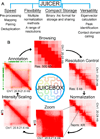Minute-Made Data Analysis: Tools for Rapid Interrogation of Hi-C Contacts
- PMID: 27716489
- PMCID: PMC5289287
- DOI: 10.1016/j.molcel.2016.09.029
Minute-Made Data Analysis: Tools for Rapid Interrogation of Hi-C Contacts
Abstract
Juicer and Juicebox, described by Durand et al. (2016a, 2016b), are two new tools for fast and reliable processing of Hi-C data, providing approaches for read processing, multiple normalization schemes, feature annotation, and dynamic browsing of chromatin contacts, thus reducing arduous Hi-C analysis into an easy yet flexible pipeline.
Copyright © 2016 Elsevier Inc. All rights reserved.
Figures

Comment on
-
Juicer Provides a One-Click System for Analyzing Loop-Resolution Hi-C Experiments.Cell Syst. 2016 Jul;3(1):95-8. doi: 10.1016/j.cels.2016.07.002. Cell Syst. 2016. PMID: 27467249 Free PMC article.
-
Juicebox Provides a Visualization System for Hi-C Contact Maps with Unlimited Zoom.Cell Syst. 2016 Jul;3(1):99-101. doi: 10.1016/j.cels.2015.07.012. Cell Syst. 2016. PMID: 27467250 Free PMC article.
References
Publication types
MeSH terms
Substances
Grants and funding
LinkOut - more resources
Full Text Sources
Other Literature Sources

